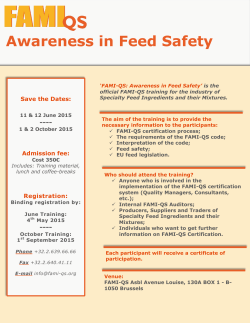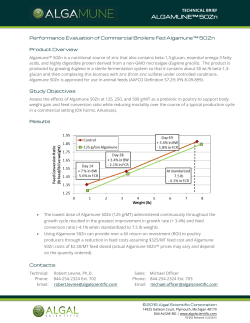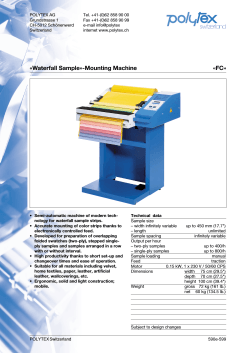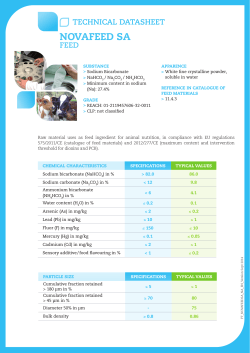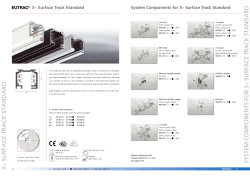
What Can You Learn From A Feed Tag
LMF GOLD LMF GOLD is a nutritionally advanced feed for athletic horses. Gold contains 12% fat. This fat originates from ground flax, sunflower seed, soybean oil, rice bran and Cool Calories 100. This combination of fat sources ensures a favorable ratio of Omega 3 to Omega 6 fatty acids. Gold also contains fermentable fiber from shredded beet pulp and soybean hulls. These fiber sources produce energy but do not add excessive amounts of sugar to the diet. The combination of fat and fiber aids in keeping performance horses focused. LMF Gold--the perfect choice for your athletic horse! WHAT CAN YOU LEARN FROM A FEED TAG?—continued from page 2 the quantity statement. The name and address of the manufacturer provides information for the customer should they have a question on the product. It also provides the state regulatory agencies with contact information if they should have a problem with the product. The quantity statement indicates the weight of the amount of feed in the bag. To date, horse feed bags typically hold 50 lbs of product. With this brief overview of horse feed tags, what can we learn from a feed tag? We can certainly learn the intended purpose of the feed and determine if this feed is correct for our horse. We can learn something about the nutrient guarantee of the product. Learning about the ingredients utilized in the feed may be difficult if the manufacturer is using “collective” LMF Feeds P.O. Box 470 Weiser, ID 83672 instead of “individual” terms. From the feeding instructions, we can learn if we have chosen a product which fits the feed requirements of our horse. If we must feed more or less feed than recommended, we need to discuss this with the manufacturer and possibly choose a different product. From the caution statement, we can learn if other supplements or feeds are necessary with this feed product. We can also learn feeding practices that may reduce the chance of sickness associated with a feed. Finally, we can learn the net weight of the product in the bag and the name and address of the feed manufacturer. Can we compare two tags and learn which feed is best? The answer is likely no, since we only have limited information available to us on the feed tag. Vol. 7 -2 What Can You Learn from a Feed Tag? Stephen Duren, Ph.D. Performance Horse Nutrition, LLC Commercially prepared, bagged, horse feed requires a feed tag. It’s the law, no exceptions. Have you ever contemplated the purpose of feed tags, or considered who controls and enforces feed tag laws? Are you curious about what information is required on a feed tag or wonder why more useful information is not contained on feed tags? You are not alone; many people read feed tags in the hope of making an informed decision on which feed may be “best” for their horse, but what can you really learn from a feed tag? The following article will dissect a commercial feed tag and explain the information contained on the feed tag. The purpose of feed tags is to protect customers and honest merchants from deception and confusion. Initially, feed tags were created to standardize weights and measures listed on feeds. Imagine the confusion if every bag of feed listed the amount contained in that bag in different units. Some would list bushels, others would list pounds and still others may list grams. Current feed tags go further in that they assure the feed meets certain standards such as guarantees of nutrient content. These guarantees provide the customer with a basis in which they can begin to compare feed products. Feed tag “rules” and “regulations” are written and enforced by the Association of American Feed Control Officials (AAFCO). Each individual state has their own regulatory personnel who are members of AAFCO. These state regulatory people are charged with the task of inspecting feed tags, testing feeds, and interpreting and enforcing feed tag rules and regulations. Since each state has their own offices and people, rules and regulations are occasionally interpreted differently in different states. In other words, a feed tag that is perfectly acceptable in Vermont may not be acceptable in California. Every commercial horse feed tag is required to contain certain information. Feed tags are to include the brand name, product name, purpose statement, guaranteed analysis, list of ingredients, directions for use, caution statements or warnings, name and address of manufacturer, and a quantity statement. All of this information is important to help the customer select a feed product that is appropriate for their individual animal. Beginning at the top of the feed tag, the brand name and/or the product name is listed. Ideally, the product name should reflect the intended use of the product. For example, a product that includes the word “Development” is assumed to be a feed for young, growing horses or pregnant mares. —continued on page 2 Mitch & JoLinn Hoover of MJ Rising H Ranch utilize and recommend LMF Feeds. Mitch and JoLinn Hoover, both trainers of versatile horses for all types of ranch work, horse show events, and specialized trail horses, work from their MJ Rising H Ranch in Richland, OR. The Hoovers have won many titles in Competitive Mountain Trail, Roping, AQHA Versatility classes, Ranch Rodeos and Cowboy Trail Challenges. LMF Horse Feeds provide MJ Rising H Ranch horses with essential nutrients for peak concentration and performance. “Our horses are exposed to many different challenges on a daily basis and LMF helps keep them healthy and focused.” Mitch & JoLinn Hoover JoLinn Hoover riding the backcountry WHAT CAN YOU LEARN FROM A FEED TAG?—continued from page 1 Since product names can be deceiving, AAFCO may also require a purpose statement to be included under the product name. A purpose statement identifies the specific group of horses for which the product is intended. A purpose statement may read: For maintenance of mature horses. This product would be intended for mature horses that are not pregnant, lactating or being worked. Another example may read: For horses in training or work. This product would be intended for horses that are being actively ridden or worked. The take home message regarding the purpose statement on a feed is to match what your horse is doing to the purpose statement. In other words, don’t feed a feed designed for a mature horse to a young, growing horse. The next item on a feed tag is the guaranteed analysis. The list of nutrients which are guaranteed is specific to different species of animals. In other words, the nutrients guaranteed on a feed intended for poultry is different than for a feed intended for horses. A commercial horse feed tag guarantees the following information: minimum crude protein, minimum crude fat, maximum crude fiber, minimum and maximum calcium, minimum phosphorus, minimum copper, minimum zinc, minimum selenium, and minimum vitamin A. Since these nutrients are guaranteed on a horse feed tag, the state feed regulatory office will actually sample and analyze the feed for these nutrients. If the feed does not contain the proper amount of nutrients, the regulatory people can issue fines and even stop the sale of the feed. Some people wonder why more nutrients are not guaranteed on the feed tag. The simple answer is that if we listed more guarantees, the state regulatory people would have to analyze for more nutrients, and they are not staffed and willing to take on this task. Another common question concerns the mathematical units used to express the guarantees. Again AAFCO designates the units, and the feed manufacturer can not deviate from the standards imposed in the rules. Selenium Fertilization Question & Answer with Dr. Stephen Duren Dr. Stephen Duren Performance Horse Nutrition What dietary changes are necessary for a horse returning to work following a layoff? Selenium is an essential nutrient for horses. Deficiencies of selenium can result in muscle weakness leading to impaired locomotion and difficulty swallowing. Selenium deficiency can also depress immune function. Many areas of the United States produce forages (hay/pasture) and grains that are selenium deficient. These crops are deficient in selenium due to low content and availability of selenium in the soil. A recent study was conducted at Oregon State University to determine if selenium fertilization could enrich selenium content of pasture plants (Filley et al. 2007). In that study, inorganic selenium in the form of sodium selenite or sodium selenate was broadcast on pasture forage consisting of perennial ryegrass and subterranean clover. Treatments were 0.0 (control), 0.6, 1.1 and 2.2 kg/ha selenium as sodium selenite and 0.6 kg/ha as sodium selenate. The selenate form was only included at the lowest level (0.6 kg/ha) because of its high availability to plants. The selenium concentrate of forage which did not receive selenium fertilization was 0.087 mg/kg. Selenium fertilization with sodium selenate (0.6 kg/ha) resulted in the greatest forage selenium concentration at 8.44±0.08 mg/kg. Both the 0.6 and 2.2 kg/ha selenite treatments provided significantly greater forage selenium content (1.17±0.05 and 4.24±0.35 mg/kg, respectively) compared to non-fertilized grass. Based on this research, it can be concluded that selenium fertilization will increase the selenium concentration in pasture forage. However, extreme care must be utilized in choosing the physical form and the amount of selenium to apply to pasture forage since the selenium levels that were produced in these experimental forages may be toxic to horses. Additional research is necessary to determine the feasibility of selenium fertilization to produce selenium enriched forages for horses. The major nutritional change necessary for a horse returning to work is an increase in the amount of calories provided in the diet. As a horse works, energy (calories) is required to fuel muscle contraction and thus movement. Chemical energy contained in feed is converted to mechanical energy that allows the horse to exercise. Therefore, the first dietary consideration is to provide more feed. Begin with the addition of more forage (hay or pasture) to the diet. Then, depending on the workload, additional calories may need to be provided in the form of grain and dietary fat. Adjusting the calorie intake of a performance horse is quite simple. If you provide too many calories, the horse becomes fat; insufficient calories will cause the horse to lose weight. In addition to calories, the working horse requires a diet fortified with protein, vitamins, and minerals. Protein is necessary to build muscle tissue. During exercise bones are remodeled to handle the stress of training. Remodeling requires the correct amounts of the minerals calcium and phosphorus. As a horse sweats to cool itself during exercise, electrolytes (sodium, chloride, potassium, magnesium, etc.) are lost from the body. These electrolytes need to be replaced for optimal exercise to continue. Vitamin E and selenium should be fortified in the diet due to their role as antioxidants and immune system stimulators. The minerals copper and iron are critical for the transportation of oxygen to the working tissues of the body. If the diet is not properly fortified, anemia can develop in horses. Therefore, the diet for a horse returning to work must provide enough calories so the horse does not lose weight and must also provide essential protein, vitamins, and minerals to replace nutrients lost during exercise and to help rebuild the body stores. Research Update Therefore, everyone will need to get used to ppm (parts per million) as a nutrient concentration. Following the guaranteed analysis is the list of ingredients. Normally, these ingredients are listed in descending order from the ingredient in highest concentration to the ingredient in lowest concentration. Not all feed companies strictly adhere to this guideline. Some companies will rearrange or group ingredients on a feed tag with only limited regard to the amount of ingredient in the feed. The other issue with listing the ingredients contained in a feed is the terms used to describe the ingredients. In general, two different sets of terminology exist: individual terms and collective terms. Individual terms list ingredients according to their common name. For example, corn is called corn and barley is called barley. Collective terms allows the manufacturer to utilize terms such as “grain products” which may include corn, barley, oats, or several other ingredients. They can also use terms such as “processed grain by-products” which may include a host of ingredients from wheat mill run to peanut skins. The problem with collective terms is that you do not know exactly which ingredient is being used or the amount of ingredient in the formula. Other collective terms often utilized include forage products, plant protein products, roughage products, and molasses products. The reason collective terminology is utilized is that it allows manufacturers the ability to eliminate ingredients or switch ratios of ingredients without constantly changing the feed tag. Unfortunately, many states do not allow manufacturers to select the terminology they would like to utilize. Therefore, if a state requires collective terms this will make it difficult for feed customers to compare feed tags. Following the list of ingredients are feeding instructions for the feed. Some states will allow feeding instructions to be printed on the feed bag rather than on the feed tag. The feeding instructions typically restate the type of horse for which the feed is intended along with a daily feed intake range that will properly fortify the horse with essential nutrients. The feeding instructions will also include guidelines for providing forage (hay or pasture) along with clean, fresh water and salt. The take home message for feeding instructions is that they provide guidelines for using the product. If the customer chooses to feed ½ of the minimum recommended level, they can not possibly hope their horse will receive adequate nutrition from the bagged feed. If your horse does not require the amount of feed indicated on the feeding instructions, simply ask the manufacturer if they have a more concentrated product that can be fed at the level of intake which makes you comfortable. Many feed tags will also contain caution statements and warnings. These warnings will vary from “do not feed moldy or insect infested feed”, to “do not feed additional sources of selenium with this product”. These statements are intended to protect the customer and ultimately their horse from sickness. Of course it is impossible to list all potential caution statements, so common sense should always prevail. If you ever have a question or concern, contact the feed manufacturer. The final piece of information on the feed tag is the name and address of the feed manufacturer along with —continued on page 4 Selenium fertilization of pastures for improved forage selenium content. 2007. S.J. Filley, A. Peters, C. Bouska, G. Pirelli and J. Oldfield. The Professional Animal Scientist 23:144-147. How many times per day should horses be fed? In a natural, free-roaming situation, horses graze nearly constantly throughout the day and night. Trying to mimic this natural feeding behavior in captive horses is a good idea but is not always possible. Horses that are confined to stalls or small drylots should be fed at least two times per day, ideally with enough hay for them to pick at continuously between feedings. Horses in strenuous training often will need to be fed more often, likely three to four times per day, to safely consume enough feed to maintain weight. Overweight horses should be fed at least twice a day, but the volume of these feedings must be reduced to accomplish weight loss.
© Copyright 2025
